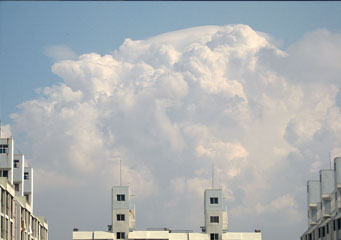
Above: Cumulonimbus Pileus
Cumulonimbus Pileus
Cumulonimbus pileus clouds are a weather warning; their formation will often indicate that heavy shower, a rain burst or a thunderstorm can be expected. If you see a cumulonimbus pileus cloud formation make plans to take cover, extreme weather could be on its way.
What are cumulonimbus pileus clouds?
Look closely at the form of a cumulonimbus pileus cloud and it should appear to you as a kind of cap. This is the reason for its name; pileus in Latin means a cloth cap. Sitting at the top of a rapidly forming cumulonimbus tower, they mark the point where the cloud encounters colder air that blocks the upward expansion of the cumulonimbus cloud.
What height are cumulonimbus pileus clouds found?
As they can be found at up to 20,000 to 30,000 feet these clouds are very important to be understood by aviators, in fact pilots receive warning instructions about them:
- Found at between 20,000 ft to 30,000ft
- Risk strong convection winds causing violent turbulence
- No weather risk as such but indicate stormy activity below
- Recommended action, do not fly into cumulonimbus pileus clouds
Classification of cumulonimbus pileus clouds
The World Meteorological Organization classifies cumulonimbus pileus clouds in the Cb category. The cumulonimbus pileus is a subset of this category, and its formation indicated that the cumulonimbus cloud has achieved a rapid growth and precipitation is likely, unless strong external winds disrupt the towers continuing growth.
How are cumulonimbus pileus clouds formed?
The cumulonimbus clouds are formed in temperate climates when the level of water evaporation from lakes, the sea or damp ground is accelerated by rising temperatures at ground level. For this reason the cumulonimbus cloud formations are normally at their most active from the mid afternoon to early evening. Strong updrafts drive the moist warm air from lower levels of the cloud toward its peak, and when the moist cloud hit a stratum of still colder air it will stop it rising and spread out into a solid looking cap.
What do cumulonimbus pileus clouds look like?
If you could imagine the towering cumulonimbus cloud or the more stable cumulus cloud looking like a rising body, the cumulonimbus pileus appears as a form of cap that sits on top of it and extends out to left and right as you look at it. Its image is smooth, and contrasts with the billowing look of a cumulonimbus cloud.
How common are cumulonimbus pileus clouds?
In arctic regions they are never seen, as there is no convection caused by heat at ground level, however in temperate regions, particularly in the summer they are far more common. In countries such as South Africa and the Czech Republic where thunderstorms are common, the sighting of cumulonimbus pileus clouds is most common.
Where can I see cumulonimbus clouds?
Look for these clouds when thunderstorms are forming, one of the best regions to find cumulonimbus pileus clouds is in northern Italy in the summer. The lakes provide the necessary moisture in summer, there is usually little surface wind and the heat of the Mediterranean sun does the rest.
